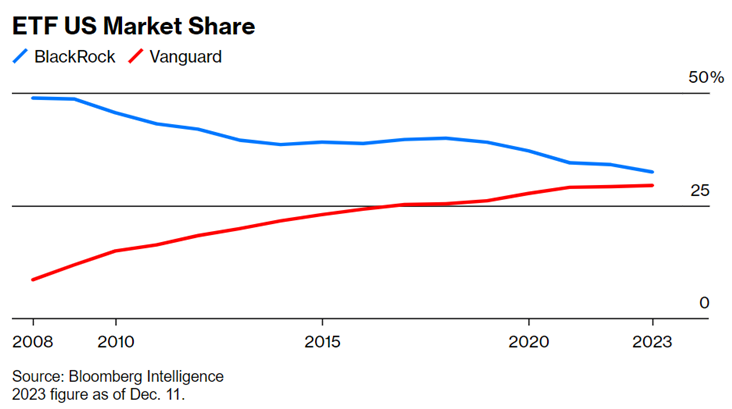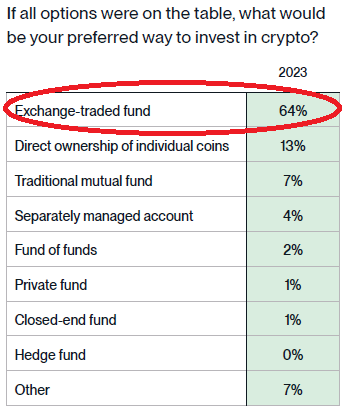As usual, let’s start with a recap of my prediction track record:
2022: 3 for 4 (one incomplete)
As I always say… Nobody. Knows. Anything. This obviously includes me if you go by last year’s predictions. After mostly nailing my calls for the past five years, there was a clear reversion to the mean in 2023. While my confidence is a bit shaken, that won’t stop me from peering into my broken crystal ball and prognosticating what 2024 holds for ETFs. As always, nothing here should be construed as investment advice – do your own homework! Also, no excuses, but I do attempt to go out on a limb with these and make some bold(er) calls. I’m not running a layup line. With that, my 2024 ETF predictions…
1) BlackRock GAINS Market Share on Vanguard
Last year, Vanguard took in nearly $160 billion in US ETF assets compared to BlackRock’s roughly $110 billion. That marked the fourth consecutive year Vanguard has topped BlackRock on the ETF leaderboard. For the better part of the past 15 years, Vanguard has methodically chipped away at BlackRock’s industry-leading market share.

Source: Bloomberg’s Katie Greifeld
The overwhelming consensus is that it’s simply a matter of time before Vanguard surpasses BlackRock. While I agree with that take, 2024 won’t be the year. As a matter of fact, I predict that BlackRock actually tops the ETF leaderboard this year and GAINS market share on Vanguard.
There are several factors playing into my calculus here. First, BlackRock took in more money than Vanguard in the fourth quarter of last year. While that’s an admittedly small sample size and fourth quarter ETF flows are notoriously noisy (tax loss harvesting, rebalancing, etc.), I think it’s an early indication of a shift. The iShares Core S&P 500 ETF (IVV) took in more money than the Vanguard S&P 500 ETF (VOO) during the quarter. The iShares Russell 2000 ETF (IWM) was among the top four flow getters. More importantly, an ETF such as the iShares MSCI Emerging Markets ex China ETF (EMXC) was in the top twenty. The simple fact is iShares has a much more robust product suite (400+ ETFs compared to Vanguard’s 84) and a more diverse investor base (i.e. more institutional business/traders, whereas Vanguard is more retail-oriented).
With questions surrounding the sustainability of last year’s equity market rally and uncertainty over the Fed’s interest rate policy, I believe investors will dig deeper in the ETF toolbox this year. That benefits iShares more than Vanguard. An important part of that will include looking to active management, an area BlackRock began to fully embrace last year after putting some of their most prominent active managers into the ETF wrapper – names like Rick Rieder (Chief Investment Officer of Global Fixed Income at BlackRock) and Tony DeSpirito (Global Chief Investment Officer of Fundamental Equities at BlackRock). Yes, Vanguard is also getting more involved with active ETFs (they rolled out several extremely low-cost active core bond ETFs last month), but most investors think “passive” when they think of Vanguard. I believe BlackRock will get many more looks on the active side.
Oh, and there is just one more little item. Only one of these issuers is involved in the spot bitcoin ETF competition. I believe that minor detail will actually be material to overall inflows this year. Sure, Vanguard will continue to vacuum-up assets just as they always do – “neither snow nor rain nor heat”. And it is probably just a matter of time before Vanguard ascends to the ETF throne. However, the current king isn’t giving up without a fight and I believe BlackRock has a banner 2024.
2) Speaking of Spot Bitcoin ETFs… They Obliterate Every ETF Launch Record
Using whatever measure you wish, I predict that spot bitcoin ETFs – when viewed cumulatively – will obliterate every ETF launch record out there. Most of my ETF colleagues believe spot bitcoin ETFs will have a somewhat lackluster debut. The reasons cited include a less frothy crypto market environment (unlike the one in October 2021 when the ProShares Bitcoin Strategy ETF (BITO) set the 1-day ETF launch record), hesitant financial advisors who will want to see a good live track record before investing, and wirehouses/wealth management platforms gating access to these products (i.e. UBS not allowing their advisors to buy spot bitcoin ETFs).
All are valid arguments, but I believe there is enough pent-up demand for spot bitcoin ETFs to overcome these hurdles. What gives me the confidence this pent-up demand actually exists? It’s very simple. Asset managers such as BlackRock, Fidelity, and Invesco – all of whom are involved in the spot bitcoin ETF race – are not in the business of pursuing small opportunities. These firms need massive hits to move the financial needle. They only get out of bed for multi-billion-dollar opportunities. I’m putting my faith in the assumption that these issuers have done their homework. I’ll even go a step further and assume these issuers have worked extremely hard behind the scenes to line up early investors. Perception will be a big factor in who wins the spot bitcoin ETF category and, rightly or wrongly, assets under management are an important data point for advisors.
And it’s not just BlackRock, Fidelity, and Invesco. Top-fifteen ETF issuers WisdomTree, VanEck, and Global X are also involved. Ever heard of ARK Invest or Franklin Templeton? They’re involved too. Oh, and Grayscale is going to convert their $26 billion Grayscale Bitcoin Trust (GBTC) into an ETF.
I’m betting on the side of these firms, who have expended countless hours and dollars (securities attorneys aren’t cheap!) to bring these ETFs to fruition. Plus, investors have clearly messaged that the ETF wrapper is their preferred way to access crypto.

Source: Bitwise
At the end of the day, these investors will respond with high demand and the ETF record books will be rewritten (as an aside, none of this is a prediction on what happens with the price of bitcoin).
3) SEC Approves Multi-Share Class Structure, Which Steals the ETF Show
While there is absolutely no question spot bitcoin ETFs will garner the headlines, I predict the multi-share class structure will steal the ETF show. Vanguard’s multi-share class fund patent expired last May. Very simply, this structure has allowed Vanguard to offer ETFs as a share class of existing mutual funds. For example, the Vanguard S&P 500 ETF (VOO) is a share class of the Vanguard 500 Index mutual fund – it’s the same pool of assets. This structure offers several important advantages, including the ability to better leverage economies of scale, which allows Vanguard to reduce backend costs and charge lower fees to investors. This structure has also helped Vanguard minimize capital gain distributions from its mutual funds since it can wash gains through the ETF share class. With Vanguard’s patent expiring, three firms filed last year with the SEC for exemptive relief to offer ETF share classes of their existing mutual funds: PGIA, Dimensional, and Fidelity. Interestingly, F/m Investments filed to do the opposite where they would offer a mutual fund share class of their single treasury bond ETFs.
Ultimately, the goal for all of these firms is the same. An ETF share class would allow mutual fund companies to maintain their lucrative 401k business while also pursuing the higher growth ETF market (or vice versa in F/m’s case). The challenge will be getting the SEC on board since Vanguard is only approved to use the ETF share class structure for index-based products, whereas these other issuers are seeking to use it for actively managed products. The SEC has expressed concern over what they call share class subsidization where ETF shareholders could be negatively impacted by mutual fund shareholders. An example would be if the mutual fund share class has significant outflows, then that could trigger negative tax consequences and higher transaction costs for ETF shareholders.
My prediction is that the SEC does, in fact, approve this structure for other issuers. And, yes, I will be tweeting about this every bit as much as I did with spot bitcoin ETFs. It’s a potentially enormous catalyst for ETF industry growth and will place mutual funds one step closer to their death bed.

Source: SEC
4) Covered Call ETF Bubble Pops
One of the most prolific ETF trends over the past two years is the rise of options-based strategies, particularly covered call strategies. The poster child is the JPMorgan Equity Premium Income ETF (JEPI), which launched in May of 2020 and is currently the largest actively managed ETF with nearly $31 billion. That includes the roughly $13 billion it took in last year, while underperforming the S&P 500 by 16% (it has trailed the S&P 500 by the same amount since its inception). The success of JEPI spawned a massive wave of copycat ETFs such as the Goldman Sachs S&P 500 Core Premium Income ETF (GPIX) and the Parametric Equity Premium Income ETF (PAPI).
Covered call strategies did perform well on a relative basis when the Fed was aggressively raising rates (JEPI was down 4% vs -18% for the S&P 500 in 2022), which attracted investors seeking to enhance income while minimizing interest rate risk, limit volatility, or both. The problem is that covered call strategies typically underperform in up markets like we experienced last year. Remember, investors are the ultimate performance-chasers. Many will look at the performance of JEPI and its ilk and decide to exit stage left. And if the stock market actually continues to rise, look out. There could be MASSIVE outflows from these ETFs.
You might recall that dividend ETFs were all the rage in 2022. Well, look at the category’s inflows in 2023:

Source: Bloomberg’s Vildana Hajric & Emily Graffeo
My prediction is that, along with a spike in covered call ETF closures, this is exactly what the category’s net inflows chart will look like at this time next year.
5) Strive Asset Management Excels During Election Year
For better or worse, 2024 is a presidential election year. Republican candidate Vivek Ramaswamy, while not gaining much ground in national GOP polling, has certainly made a name for himself. Even if Ramaswamy drops out of the GOP presidential primary, there are rumors floating around that he could be considered as Donald Trump’s running mate. Why am I talking about Vivek in an ETF blog? Well, prior to running for President, guess what Vivek co-founded? An ETF issuer by the name of Strive, whose mission is the following:
“Strive was created in January 2022 to solve a problem that had emerged in the United States over the prior decade: large financial institutions, including the biggest asset managers, were using their clients’ money to advance social, cultural, and political agendas in corporate America’s boardrooms.”
In a nutshell, Strive is seeking to “depoliticize corporate America” and has been called an “anti-ESG” or “anti-woke” firm.
BlackRock, State Street, and Vanguard represent the most powerful cartel in human history: they’re the largest shareholders of nearly every major public company (even of each other). They use your own money to create a country that you never voted for. As President I will cut off… pic.twitter.com/GzHghNuAlS
— Vivek Ramaswamy (@VivekGRamaswamy) December 21, 2023
Strive launched its first ETF in August of 2022 and now offers 11 ETFs with over $1 billion in assets. My prediction is that Strive easily doubles its assets in 2024 and begins to meaningfully move up the ETF leaderboard. What better marketing opportunity for an ETF issuer than to have your co-founder literally EVERYWHERE pitching the company’s underlying mission? Sure, you might alienate half of your prospective clients. However, you will also create some highly passionate fans out of the other half. Regardless of whether you agree with his politics, there is no question Vivek is helping Strive get its name and mission out in the marketplace. That type of visibility goes a long way in the brutally competitive ETF industry.
The other factor in my prediction is that ESG ETFs have had a pretty rough go of it recently. The category saw $8 billion in outflows last year and there seems to be a narrative shift away from “wokeness”. That can only help a firm like Strive.
By the way, you can listen to my ETF Prime interview with Vivek here:

